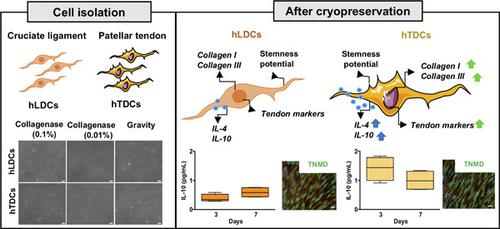当前位置:
X-MOL 学术
›
J. Cell. Physiol.
›
论文详情
Our official English website, www.x-mol.net, welcomes your
feedback! (Note: you will need to create a separate account there.)
The impact of cryopreservation in signature markers and immunomodulatory profile of tendon and ligament derived cells
Journal of Cellular Physiology ( IF 4.5 ) Pub Date : 2021-08-08 , DOI: 10.1002/jcp.30540 Ana I Gonçalves 1, 2 , Adriana Vinhas 1, 2 , Márcia T Rodrigues 1, 2 , Manuela E Gomes 1, 2
Journal of Cellular Physiology ( IF 4.5 ) Pub Date : 2021-08-08 , DOI: 10.1002/jcp.30540 Ana I Gonçalves 1, 2 , Adriana Vinhas 1, 2 , Márcia T Rodrigues 1, 2 , Manuela E Gomes 1, 2
Affiliation

|
Tendon and ligament (T/L) engineering strategies towards clinical practice have been challenged by a paucity of understanding in the identification and still poorly described characterization of cellular niches. Prospecting how resident cell populations behave in vitro, and how cryopreservation may influence T/
L-promoting factors, can provide insights into T/
L-cellular profiles for novel regenerative solutions. Therefore, we studied human T/
L-derived cells isolated from patellar tendons and cruciate ligaments as suitable cellular models to anticipate tendon and ligament niches responses for advanced strategies with predictive tenogenic and ligamentogenic value. Our results show that the crude populations isolated from tendon and ligament tissues hold a stem cell subset and share a similar behavior in terms of tenogenic/ligamentogenic commitment. Both T/
L-derived cells successfully undergo cryopreservation/thawing maintaining the tenogenic/ligamentogenic profiles. The major differences between cryopreserved and fresh populations were observed at the gene expression of MKX, SCX, and TNMD as well as at the protein levels of collagen type I and III, in which cells from tendon origin (hTDCs) evidence increased values in comparison to the ones from ligament (hLDCs, p < 0.05). In addition, low-temperature storage was shown to potentiate an immunomodulatory profile of cells, especially in hTDCs leading to an increase in the gene expression of the anti-inflammatory factors IL-4 and IL-10 (p < 0.05), as well as in the protein secretion of IL-10 (p < 0.01) and IL-4 (p < 0.001). Overall, the outcomes highlight the relevance of the cryopreserved T/
L-derived cells and their promising immunomodulatory cues as in vitro models for investigating cell-mediated mechanisms driving tissue healing and regeneration.
中文翻译:

冷冻保存对肌腱和韧带衍生细胞的特征标记和免疫调节谱的影响
针对临床实践的肌腱和韧带 (T/L) 工程策略受到了对细胞生态位识别缺乏理解和仍然描述不佳的描述的挑战。探索常驻细胞群在体外的行为方式,以及冷冻保存如何影响 T/ L促进因子,可以提供对新型再生解决方案的 T/ L细胞谱的见解 。因此,我们研究了人类 T/ L从髌腱和十字韧带中分离出的衍生细胞作为合适的细胞模型来预测腱和韧带生态位的反应,用于具有预测腱生成和韧带生成价值的高级策略。我们的研究结果表明,从肌腱和韧带组织中分离出来的原始种群拥有一个干细胞亚群,并且在肌腱/韧带形成承诺方面具有相似的行为。两种源自 T/ L的细胞都成功地进行了冷冻保存/解冻,维持了致韧带/韧带的分布。在MKX、SCX和TNMD的基因表达上观察到冷冻和新鲜种群之间的主要差异以及 I 型和 III 型胶原蛋白的蛋白质水平,其中来自肌腱来源的细胞 (hTDCs) 的值与来自韧带的细胞相比有所增加 (hLDCs, p < 0.05)。此外,低温储存可增强细胞的免疫调节特性,尤其是在 hTDC 中,导致抗炎因子IL-4和IL-10的基因表达增加(p < 0.05),以及在 IL-10 ( p < 0.01) 和 IL-4 ( p < 0.001) 的蛋白质分泌中。总体而言,结果突出了冷冻保存的 T/ L的相关性衍生细胞及其作为体外模型的有希望的免疫调节线索,用于研究驱动组织愈合和再生的细胞介导机制。
更新日期:2021-08-08
中文翻译:

冷冻保存对肌腱和韧带衍生细胞的特征标记和免疫调节谱的影响
针对临床实践的肌腱和韧带 (T/L) 工程策略受到了对细胞生态位识别缺乏理解和仍然描述不佳的描述的挑战。探索常驻细胞群在体外的行为方式,以及冷冻保存如何影响 T/ L促进因子,可以提供对新型再生解决方案的 T/ L细胞谱的见解 。因此,我们研究了人类 T/ L从髌腱和十字韧带中分离出的衍生细胞作为合适的细胞模型来预测腱和韧带生态位的反应,用于具有预测腱生成和韧带生成价值的高级策略。我们的研究结果表明,从肌腱和韧带组织中分离出来的原始种群拥有一个干细胞亚群,并且在肌腱/韧带形成承诺方面具有相似的行为。两种源自 T/ L的细胞都成功地进行了冷冻保存/解冻,维持了致韧带/韧带的分布。在MKX、SCX和TNMD的基因表达上观察到冷冻和新鲜种群之间的主要差异以及 I 型和 III 型胶原蛋白的蛋白质水平,其中来自肌腱来源的细胞 (hTDCs) 的值与来自韧带的细胞相比有所增加 (hLDCs, p < 0.05)。此外,低温储存可增强细胞的免疫调节特性,尤其是在 hTDC 中,导致抗炎因子IL-4和IL-10的基因表达增加(p < 0.05),以及在 IL-10 ( p < 0.01) 和 IL-4 ( p < 0.001) 的蛋白质分泌中。总体而言,结果突出了冷冻保存的 T/ L的相关性衍生细胞及其作为体外模型的有希望的免疫调节线索,用于研究驱动组织愈合和再生的细胞介导机制。











































 京公网安备 11010802027423号
京公网安备 11010802027423号